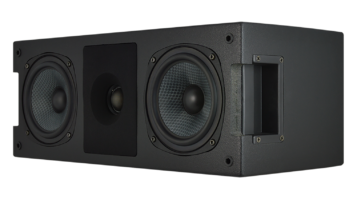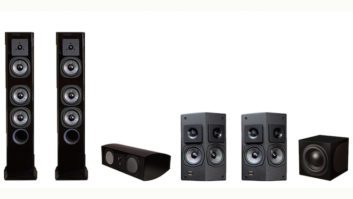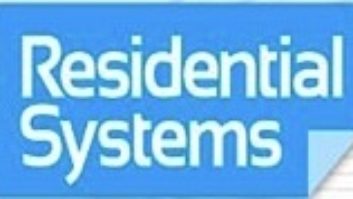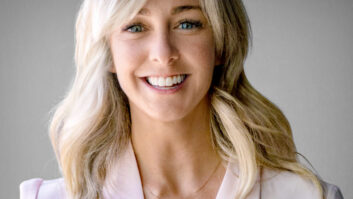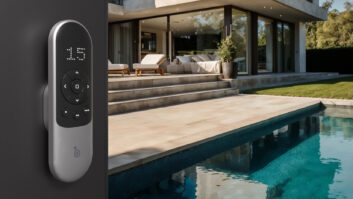Room correction and equalization certainly aren’t new concepts, nor do they carry the witchcraft and voodoo stigmas of some other audiophile “improvements.” (Green markers on your CDs anyone?) Yet, properly measuring and calibrating a system for a room is far more science than guesswork, and without the right tools, you’re likely to do as much harm as good. And if you lack the gear, training, and expertise, you’ve likely been unable to offer your clients any kind of improvement solution.
Since 2004, Audyssey’s software has been included in a number of consumer AV components, primarily receivers and pre-pros. After analyzing some test-tones via an included microphone, Audyssey’s software sets speaker levels, crossover settings, channel delay, and performs some advanced filtering to correct for the negative effect of the room’s acoustics.
But as Yoda said, “There is another…” If you install Denon, Marantz, Onkyo, Integra, NAD, or Crestron systems, then you can offer your customers a step up over the basic Audyssey calibration via the MultEQ Pro Calibration Kit. The calibration kit sells for $400 and includes all of the parts needed for performing a professional room calibration. If you are a dealer for one of the above brands, then your manufacturer’s rep can discuss the steps required to obtain the kit.

The Audyssey MultEQ Pro Calibration Kit is a step up over the basic software solution. The “travel bag” includes a calibrated microphone and holder, MultEQ Pro software, Microphone calibration file, microphone stand, microphone pre-amp and power supply, microphone connection cables, and USB to Serial adapter.
Only “Installer Ready” components can be calibrated, and each calibration requires purchasing a $150 license from Audyssey, with licenses specific to the unit being calibrated (ie: a Denon license won’t work on an Integra). Once applied, the license is “mated” to the serial number of that unit. While installers are free to charge whatever they like for the service, Audyssey recommends around $500, including the $150 license. As a full calibration–equipment set up, measurement time, microphone relocation, filter processing, report generating, and equipment breakdown–would likely take around two hours, this seems reasonable and delivers a significant result for the end user.
After obtaining a license for my Marantz AV7005 pre-pro, I was ready to start the calibration. I installed the MultEQ Pro software onto my computer, connected my computer via USB to the Marantz’s serial connection and… nothing. My computer couldn’t see the receiver. After about an hour of phone troubleshooting with Audyssey, it appeared that the old USB-toserial conflict monster was rearing its ugly head. Fortunately, I was able to get my hands on a different computer with an actual serial connection that worked immediately. If you are stuck with a computer running USB only, be aware that you might run into issues.
The actual measurement process is identical to Audyssey’s traditional system; a series of WHAP-WHAP-WHAP tones are emitted from each speaker and measured by the microphone. But a significant difference here is the caliber of the microphone. Instead of a generic, mass-produced plastic microphone that rolls off an assembly line, the Pro Cal kit uses a model individually calibrated to match the response of the $5,000 reference mic at Audyssey’s labs. Then each microphone’s specific response curve is included with the calibration software. This allows for far more accurate readings, producing more accurate results.
Another significant advantage is the ability to measure up to 32 positions versus six or eight of the standard versions. Plus, measurements can be saved, recalled, added to, or deleted at a later date, making it easy to go back and redo something. Measuring my 9.1 system took nearly four minutes per position. One challenge to the calibration process isgetting–and keeping!–the room totally quiet during measurements. Following the measurement process, a target curve is selected–or can be manually customized as another benefit of the Pro version–and then the filters are downloaded and saved to the component. Upon completion, a nice before-and-after chart is available demonstrating the improvements made to the system.

Audyssey’s MultEQ Pro software generates before-and-after response curves from each speaker channel, allowing installers to clearly illustrate what the improvements the software is making. Notice the greatly smoothed response curve—especially the removal of lumpy bass—in John Sciacca’s graphs.
Sonically, the end results vary from, “That sounds better” to “Holy crap! That sounds WAY better!” When turning the EQ on and off, sounds are tighter, more focused, and more localizable. Imagine the audio equivalent to making that final focus adjustment on a projector where a slightly hazy line comes into per-pixel focus. Dialog is more intelligible with less of that, “What did they say?” issue. Voices sound more consistent as they pan from channel to channel. It’s as if your system dropped the bloat and is now lean, agile, and tight. But the biggest improvement was clearly in bass response. Notes that sometimes weren’t even audible now have depth, weight, and clarity. A bass note from The Crystal Method’s “High Roller” that had been lost in the mire now had its intended depth. Likewise cannon blasts and explosions were more distinct and defined, more powerful, and convincing. Whether listening to movies or music, the Audyssey MultEQ processing delivered a consistently dramatic improvement in bass resolution and performance.
The Audyssey MultEQ Pro Cal Kit requires a minimal investment and offers an easy-to-explain and demonstrate improvement to clients, allowing installers not only an additional revenue stream, but a way to differentiate their installs from the competition.
Kudos
Professional-looking travel kit helps cement your validity as well as organizes your gear; before and after “Certificate” easily demonstrates the results.
Concerns
Serial connection issues can rear their ugly head; finding one-plus hours of absolute quiet time to complete the calibration will be a challenge for most of us.
Product Specs
*Pro license allows for up to 32 measurements
*Response curve can be customized
*Client measurement files can be saved and recalled for later use
*Produces a before-and-after calibration certificate displaying results
